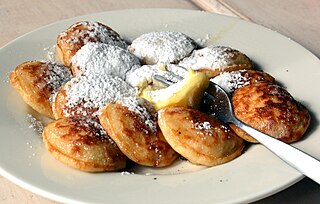
Poffertjes are a traditional Dutch batter treat. Resembling small, fluffy pancakes, they are made with yeast and buckwheat flour.

Motabbaq is a stuffed pancake or pan-fried bread which is commonly found in the Arabian Peninsula and Southeast Asia, notably in Saudi Arabia, Yemen, Indonesia, Malaysia, Singapore, Brunei, Thailand and Bangladesh. Depending on the location, the name and ingredients can significantly vary. The name mutabbaq in Arabic means "folded". It is a popular street food in Yemen, Indonesia, Malaysia, Thailand and Singapore.

Kue is an Indonesian bite-sized snack or dessert food. Kue is a fairly broad term in Indonesian to describe a wide variety of snacks including cakes, cookies, fritters, pies, scones, and patisserie. Kue are made from a variety of ingredients in various forms; some are steamed, fried or baked. Kue are popular snacks in Indonesia, which has the largest variety of kue. Because of the countries' historical colonial ties, Koeé (kue) is also popular in the Netherlands.

Spekkoek is a type of Indonesian layer cake. It was developed during colonial times in the Dutch East Indies. The firm-textured cake is an Indo (Dutch-Indonesian) version of the European multi-layered spit cake. However it is not baked on a rotating spit, and contains a mix of Indonesian spices, such as cardamom, cinnamon, clove, mace and anise. The cake is made of flour and yolk and is rich in butter or margarine.

Pineapple tart is a small, bite-size tart filled or topped with pineapple jam, commonly found throughout different parts of Southeast Asia such as Indonesia, Malaysia, Brunei and Singapore in various forms.
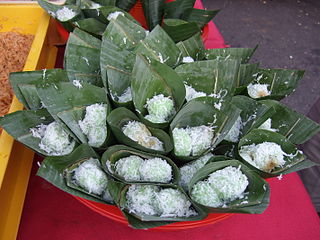
Klepon, or kelepon, is a snack of sweet rice cake balls filled with molten palm sugar and coated in grated coconut. Of Javanese origin, the green-coloured glutinous rice balls are one of the popular traditional kue in Indonesian cuisine. It is also commonly found in neighbouring countries such as Malaysia, Brunei and Singapore as onde-onde.

Semprit is made of wheat flour, corn starch, custard powder, sugar and margarine. These ingredients are mixed together to become a dough. Next, the dough is rolled and cut into small pieces, which are baked until golden yellow. Semprit is ready to eat once it has cooled to room temperature.

Kue semprong, Asian egg roll, sapit, sepit, kue Belanda, or kapit, is an Indonesian traditional wafer snack made by clasping egg batter using an iron mold which is heated up on a charcoal stove. It is commonly found in Indonesia, Malaysia, Singapore and Brunei.
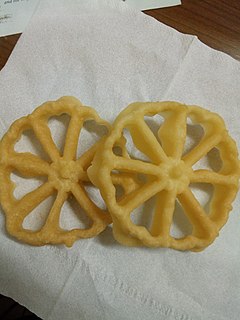
Kue kembang goyang or kuih loyang is an Indonesian cuisine and Malaysian cuisine flower-shaped traditional snack (kuih), associated with Betawi cuisine and Malay cuisine.
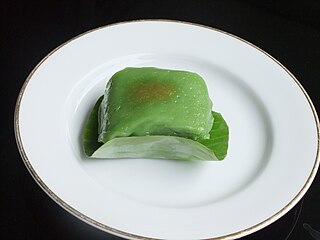
Kue bugis is Indonesian kue or traditional snack of soft glutinous rice flour cake, filled with sweet grated coconut. The name is suggested to be related to Bugis ethnic group of South Sulawesi as their traditional delicacy, and it is originated from Makassar. In Java the almost identical kue is called kue mendut. Kue bugis, together with kue lapis and nagasari are among popular kue or Indonesian traditional sweet snacks, commonly found in Indonesian traditional marketplace as jajan pasar.

Kaasstengels, Kastengel or kue keju are a Dutch cheese snack in the shape of sticks. Owed to its colonial links to the Netherlands, kaasstengels are also commonly found in Indonesia. The name refers to its ingredients, shape and origin; kaas is the Dutch word for "cheese", while stengels means "sticks". Unlike most cookies, kaasstengels taste savoury and salty instead of sweet. In Indonesia kaasstengels, together with nastar and putri salju are the popular kue kering during festive occasion, such as Natal (Christmas) and Lebaran.

Kue gapit is an Indonesian kue kering which originates from Cirebon, West Java. Generally made from tapioca flour, its name comes from the cooking process, in which it is grilled between iron molds like a waffle. The snack comes in a variety of shapes and flavors. Though it is a popular souvenir among visitors to Cirebon, residents of the region rarely eat it.
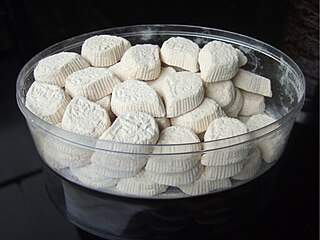
Kue satu or kue koya is a popular traditional kue kering made of sweet white-colored mung bean powder that crumbles when bitten. It is commonly found as a traditional cookie in Indonesia, especially in Java. In Indonesia, this cookie is often served during festive occasions, such as Lebaran, Natal (Christmas), and Imlek. It is believed that the cookies were derived from Chinese Peranakan traditional cookies or dry kue.
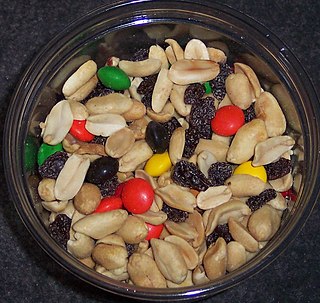
A snack is a small portion of food generally eaten between meals. Snacks come in a variety of forms including packaged snack foods and other processed foods, as well as items made from fresh ingredients at home.

Palembangese cuisine is the cuisine of the Palembangese people of the city of Palembang in the South Sumatra province of Indonesia. It is the second most well-known cuisine from Sumatra after Padang.

Kue lidah kucing is a small Indonesian biscuit shaped somewhat like a cat's tongue. They are sweet and crunchy. This cookie is a Dutch-influenced cookie due to the historical tie between Indonesia and the Netherlands. In the Netherlands, this cookie is known as kattentong, and ultimately derived from European cat tongue biscuit.

Kue rangi or also called sagu rangi is an Indonesian coconut kue or traditional snack made of a coconut and starch-based batter and cooked in a special molded pan. It is one of the traditional Betawi snack of Jakarta. Kue rangi often described as Indonesian coconut waffle.

Kue talam is an Indonesian kue or traditional steamed snack made of a rice flour, coconut milk and other ingredients in a mold pan called talam which means "tray" in Indonesian. The cake mold used to create kue talam are either larger rectangular aluminium tray or smaller singular cups made from ceramics, aluminium, melamine or plastic.

Kue bangkit is a small biscuit that made from sago starch of Malay origin, commonly found in Indonesia and Malaysia. This biscuit has various colours, ranging from white, yellowish to brown, depends on the additional ingredients.
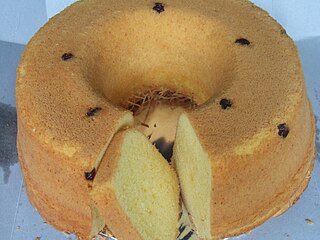
Kue bolu or simply Bolu is an Indonesian term to describes a wide variety of sponge cakes, tarts and cupcakes.






















